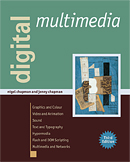
See the book at amazon.co.uk or amazon.com
Related Books

See Digital Multimedia at amazon.co.uk or amazon.com

See Web Design: A Complete Introduction at amazon.co.uk or amazon.com
The authors are not responsible for the content of any external sites linked to from digitalmediatools.org
All material on this site is ©2007–2010 MacAvon Media and may not be reproduced without permission.
Teaching Notes Overview
Chapters from Digital Media Tools, 3rd edition in PDF format to download can now be included in MacAvon Media Course Bundles for purchase by students from the MacAvon Media Downloads Store. Course bundles can be constructed by bona fide college lecturers or instructors through a MacAvon Media Lecturer’s Account. Lecturers’ Accounts also enable lecturers to obtain free evaluation copies in PDF format.
We cannot hope to give advice to everyone who might be teaching courses based on Digital Media Tools. We know that the book will be used in many countries around the world, and that the educational systems and teaching styles differ greatly, not only in different countries but within a single country. We expect that in some places, students will be expected to learn to use the programs on their own with some help from reading the book, whereas in others, they will be given formal lectures, and in others they will be getting one-to-one tuition while they use the programs. Nevertheless, we have thought it worthwhile providing some general guidelines on how the book might be used, in the hope that they may be of some use, especially to people who are just starting out on a teaching career.
If you are giving lectures based directly on the book, the "Don't Forget" slides summarize the most important points in each chapter.
Each chapter is arranged in a logical order with basic aspects first, from which more advanced ideas can be developed. As we state in the preface, the approach is practice-based, with small exercises building up proficiency with each feature. This is a sound approach to teaching but it can be frustrating for students who will understandably want to produce impressive work straight away. Nevertheless, like practising musical scales, it is a well-founded route to mastering the tools.
Our experience teaching these programs in an art college strongly suggests that the most likely problem you will encounter – especially with art and design students, we suspect – is that students will want to run before they can walk. They may be highly motivated to produce a piece of work that requires advanced features, and will be reluctant to get to know the basics first. If you are teaching on an individual basis, you may be able to produce a route through the material which gets them to the point where they can produce the work they want to in a short time, but this may require omitting essential material that will be needed later.
We expect that students with a strong computing background will underestimate the difficulty of using the programs. There is no programming or mathematics involved, or any of the technical detail they probably associate with difficult subjects, so they will expect things to be easy. You may need to emphasize that these are professional tools, which can be just as hard to master as a programming language.
Generally, we have found a tendency among all sorts of novices to assume that they should be able to pick up the use of a program like Photoshop without looking at a manual. They reason that the interface looks like things they are familiar with, so they should be able to figure things out just by pulling down menus and trying some commands. This will not get most people very far, but it will get them further in some programs (Photoshop, perhaps) than in others (Flash or Dreamweaver). Again, it is necessary for the instructor to explain that these are professional tools that can take years to master fully, and that assistance, both in person and from the book and other sources, is helpful.